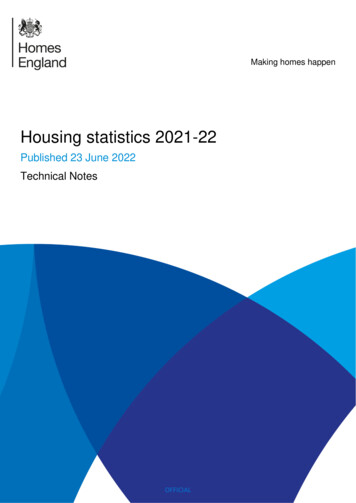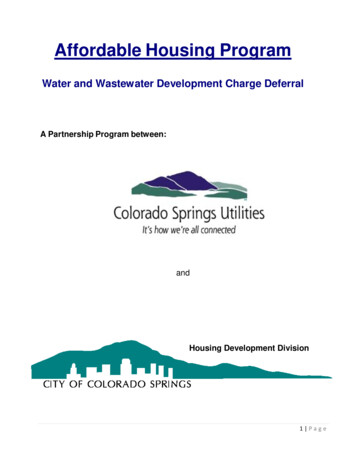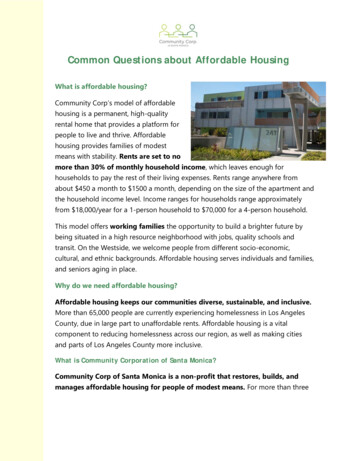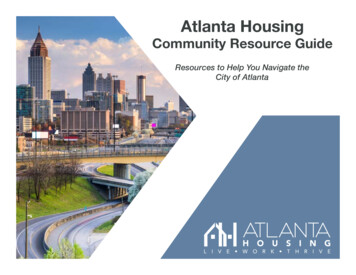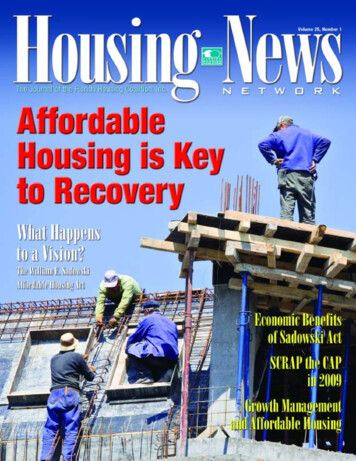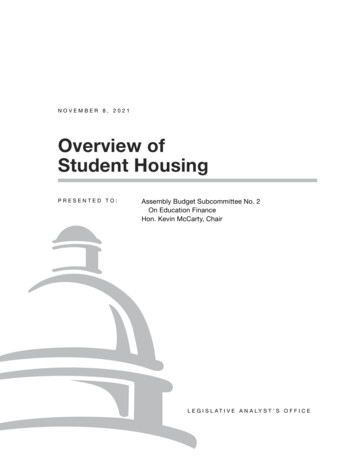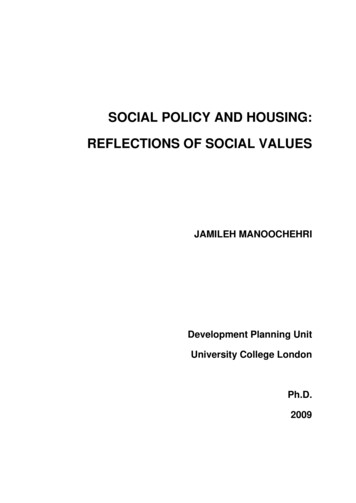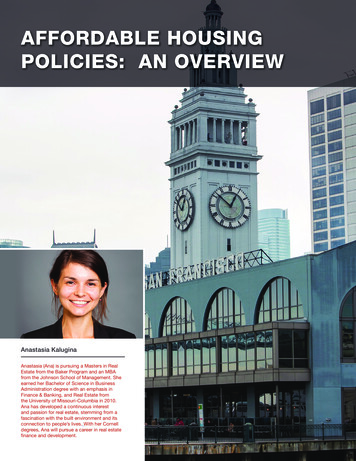
Transcription
AFFORDABLE HOUSINGPOLICIES: AN OVERVIEWAnastasia KaluginaAnastasia (Ana) is pursuing a Masters in RealEstate from the Baker Program and an MBAfrom the Johnson School of Management. Sheearned her Bachelor of Science in BusinessAdministration degree with an emphasis inFinance & Banking, and Real Estate fromthe University of Missouri-Columbia in 2010.Ana has developed a continuous interestand passion for real estate, stemming from afascination with the built environment and itsconnection to people’s lives. With her Cornelldegrees, Ana will pursue a career in real estatefinance and development.76
IntroductionAs urban housing markets throughout the United States increasingly exhibit challenges of affordability,federal, state, and local governments have placed renewed emphasis on housing, specifically mixedincome housing, which integrates affordable housing incentives into multifamily development projects.With such incentives, one must wonder what comprises a successful affordable housing policy and howaffordable housing can be successfully implemented into a community. This article attempts to answerthese questions by detailing the history of affordable housing policies, exploring some of the currentaffordable housing policies and programs, comparing affordable housing programs from differentregions, and discussing some successful affordable housing programs and lessons that can be learnedfrom them.I. AFFORDABLE HOUSING DEFINITIONAlthough the typical definition of affordable housingvaries from one jurisdiction to another, affordable housingis generally defined as housing for which an occupantpays no more than 30% of his or her income for grosshousing expenses such as rent and utilities. Therefore, thepopulation of those eligible to live in affordable housing unitsis diverse: no specific market and no specific demographiccomes close to encompassing all who live in these units.For example, households earning at the national median inNew York and San Francisco may be eligible for affordablehousing in those cities due to high housing costs, while inother locations, households earning at the national medianmay not.Even before the Great Recession, the percentage ofAmericans paying more than 30% of their gross incomesfor housing was increasing. Approximately 75% of rentersin the ten highest-cost metropolitan areas earning between 30,000 and 45,000, and almost 50% of those earningbetween 45,000 and 75,000 had high housing costs. In2015, only 25% of eligible households received housingassistance. The other 75% of the eligible population paid adisproportionate share of income on housing.II. AFFORDABLE HOUSING THROUGHOUT HISTORY:FROM GOVERNMENT REGULATION TO PUBLICPRIVATE PARTNERSHIPSThroughout American history, affordable housing has beenused as a public policy tool. In the twentieth century it wasused during the Great Depression, and following World WarII, when a housing shortage resulted from soldiers returningFigure 1: Policy Timelinehome to start families.During the 1960s, policies weredesigned to alleviate civil unrest, and in the 1970s, housingpolicies were used to stimulate the struggling economy.Throughout the 20th Century, housing policies have beeninstrumental in creating the incentives and initiatives thathave facilitated the development of partnerships among77
non-profits, the private sector, and the government.During the Great Depression, Congress’s primaryobjective was to ensure that every American had theopportunity to own a house. This objective stabilized thehousing market, created thousands of construction jobs,and provided affordable housing to millions of people whilesimultaneously alleviating slum conditions in certain cities.The National Housing Act of 1934 created the FederalHousing Administration (FHA). The FHA’s primary chargewas to insure the availability of single-family housingloans and to regulate interest rates and mortgage terms.The Act was the building-block of the current mortgagesystem, and it revolutionized home ownership in the UnitedStates, which, at the time, required buyers to make large downpayments. Although well intended, the strict loan originationguidelines facilitated racial and ethnic discrimination.After years of lobbying by pro-housing advocates, in 1937the United States Housing Act was passed, which createdthe Unites States Public Housing Authority (USPHA). Theauthority was authorized to make loans, provide capital tolocal agencies, and formulate guidelines for new housing –creating a mechanism through which various constructionprojects were financed. It was also responsible for buildingpublically-subsidized housing, and required one unit to bebuilt for every unit demolished, ensuring that the quality ofaffordable housing improves. At about the same time, thePublic Housing Authority (PHA) was created and tasked withmaking decisions in regards to public housing availability,selecting sites for public housing projects, making operationaland ownership decisions for existing housing projects, andissuing tax-exempt bonds for construction financing.The Housing Act of 1949 expanded the USPHA programand attempted to ensure that all Americans had a “decenthome and a suitable living environment.” The legislationwas the first comprehensive housing act that emphasizedthe quality of the urban built-environment, addresseddeteriorating urban conditions, and used the government tostimulate private sector construction of public housing viagovernment-backed financing. The program was open toanyone who qualified, but veterans and families displacedby urban redevelopment were given preference for the lowrent housing.The Housing Acts of 1956 and 1961 expanded the federalgovernment’s role and allowed for private investment inaffordable housing by incentivizing developers through lowerinsurance and mortgage rate subsidies. The acts linkedfederal and local affordable housing policies and emphasizedprivate sector participation in subsequent affordable housingdevelopments. Over time, private sector developers becamethe main supplier of affordable housing units, and the public78perception of affordable housing projects became morepositive. In the same time frame, the Housing Act of 1959(Section 202) provided for direct low-interest loan paymentsto nonprofit developers building housing for the elderly.The Housing and Urban Development Act of 1965greatly expanded funding for housing programs, enhancedthe urban renewal programs created by the 1949Housing Act, and created Section 23 (later Section 8).The original intent of Section 23 was utilizing the existinghousing stock and to provide for the leasing of rentalunits over long-term periods to low-income individuals.In 1968, Section 236 passed, which facilitated full-scaleprivate development efforts of affordable housing. Underthis program, private developers were eligible to receivebank loans subsidized by HUD. Although the program waspopular, and lead to the creation of more than 500,000 units,it was inflexible during inflationary times because it reliedupon the assumption that rental revenues would alwayscover a building’s operating expenses, annual debt service,and a return to the owner.Over time the changing regulations resulted in changesto the underlying business of Public Housing Authorities(PHAs). For example, following the Brooke Amendment,the maximum rent that tenants of subsidized housing wereallowed to pay was capped at a percentage of their annualmedian incomes. This reduced the revenues generated byPHAs. Concurrently, the federal government decreased theamount of subsidies available for operating public housingprojects, which caused conditions at many sites to deterioraterapidly. In addition, the priority admittance into public housingfor those facing extreme poverty reduced PHA’s rentalrevenues and operating margins, and consequently, mademany public housing projects less-desirable for occupantsdue to the lack of proper management and maintenance.Over time however, PHAs became more entrepreneurial,culminating in the creation of the Low Income Housing TaxCredit (LIHTC) in 1986 following the passage of the TaxReform Act. The HOPE VI program adopted in 1993 ledto the demolition of many distressed housing projects andreplaced them with new, mostly mixed-income developments.Although the program was highly successful, it displacedtenants who had lived in these housing projects. Otherprograms that combined the efforts of public agencies andprivate organizations were the Housing Choice Program,and project-based voucher programs.III. CURRENT AFFORDABLE HOUSING PROGRAMSContemporary housing policies are tremendously diverse,and local governments often have their own variations onfederal programs. Overall, the programs can be grouped
Figure 2: LIHTC Calculationinto three main approaches:rental assistance, homeownershipassistance, and land use andregulatory incentives.Examples of rental assistanceprograms are the Low IncomeHousing Tax Credit and housingvouchers. The rental assistanceprogram incentivizes the productionand maintenance of affordablerental housing stock for low tomoderate-income individuals andfamilies. Other rental assistanceprograms focus on helping lowincome renters obtain quality rentalhousing.The second approach is throughhomeownership assistance programs that seek to expandaccess to homeownership. Such programs subsidizethe production and rehabilitation of for-sale housing.These programs provide low-interest loans to perspectivehomeowners, homeownership counseling, and downpayment assistance.The third approach incorporates land use and regulatoryinitiatives that give private developers guidance in regards tothe location, characteristics, and cost of affordable housingdevelopments. Some examples of this approach includelocal land use regulations and building codes, inclusionaryzoning regulations, and smart growth initiatives.A. Low Income Housing Tax Credit (LIHTC)LIHTC is considered the most significant federalgovernment housing initiative. The program helps todevelop new, and preserve existing affordable housing unitsby incentivizing developers to invest in affordable housingthrough leveraging dollar-for-dollar federal income tax creditsawarded on a per-project basis. Although technically not afederal program, but an item in the IRS Tax Code, LIHTCaccounts for one-sixth of all multifamily housing units builtin the first twenty years following its establishment in 1986.According to HUD, the program gives state and localagencies the ability to issue roughly 8 billion in tax creditsfor the acquisition, new construction, and rehabilitation oflow-income rental housing. Each state receives an annualhousing tax credit that is determined by state population(about 2.20 per resident in 2012) and must be used within a2-year time period or be returned to the federal governmentfor redistribution. Although each state determines its owncriteria for evaluating projects and eventual distribution offunds, federal law requires that at least 10% of the totalavailable credit amount be allocated to non-profit housingdevelopments, and priority be given to very low-incomepopulations.LIHTC acts as a catalyst driving developers’ financingof affordable rental housing development by giving them adollar-for-dollar reduction in tax liability in exchange. LIHTCis used to subsidize either 30% or 70% of the affordable unitsin a project. The percentage depends on whether additionalsubsidies are used in a project. A 30% subsidy (4% taxcredit) is applied to new construction projects that use othersubsidies, or to qualify for the credit, a developer is eitherrequired to allocate 40% of the units to renters making nomore than 60% of the area median income (AMI) or 20% ofthe units must be allocated to renters making no more than50% of the area’s median income.1 The credits are claimedover a 10-year time period, during which, taxes are offsetby the tax credit investor that purchased the credits fromthe developer at the outset of the project. The property mustremain occupied by low-income households for thirty years:a 15-year initial compliance period and a subsequent 15year extended-use period, with some states requiring evenlonger compliance periods because of the competitivenessof the tax credits.2Since the demand for affordable housing is high, projectsqualifying for LIHTC credits tend to have low vacancyrates and quick lease-up periods. The LIHTC program setsmaximum rents as a percentage of area median income.3 Inessence, the LIHTC credit incentives offset the developer’sinability to charge higher rents over the period of tax creditcompliance. Since the program’s creation, it has helpedto preserve and finance more than two million rental unitsof affordable housing,4 placing an average of over 1,450projects and 110,000 units in service each year.579
B. HOPE IV and Choice Neighborhoods ProgramCreated in the 1990s, the HOPE IV program wasestablished to transform public housing projects intomixed-income communities. Key objectives of the HOPEIV program include changing the design of public housing,establishing incentives for resident self-sufficiency, creatingcomprehensive services that empower residents, andlimiting the concentration of poverty by placing publichousing in areas that haven’t historically contained it.6 Theprogram creates partnerships between private developersand non-profits to redevelop the most severely-distressedpublic housing projects and demolish distressed publichousing projects to replace them with smaller, mixed-incomedevelopments.7 The funds for HOPE IV projects come fromthe private sector, and typically a combination of federal andstate funding resources such as LIHTC.8 From its creationin the 90s through 2010, HOPE IV has awarded more than 6.3 billion to 133 public housing authorities via grants for262 projects.9In 2010, the Choice Neighborhood Program (CNP)was created to capitalize on the success of the HOPE IVprogram by continuing many of its innovations such as takingadvantage of public-private partnerships in redevelopingpublic housing, and by extending eligibility to privately-ownedfederally-subsidized developments. CNP requires granteesto build at least one housing unit for every unit of affordablehousing that is demolished in the target development area –a stipulation that the original HOPE IV program omitted, andwas often criticized for.C. New Market Tax Credit (NMTC)The NMTC was created in 2000 with the passage of theCommunity Renewal Tax Relief Act. The program’s goal isto spur the revitalization of low-income communities thatsuffer from a lack of investment. Under the NMTC program,individual and corporate investors receive federal incometax credits in exchange for contributing equity to specializedfinancial intermediaries, called Community DevelopmentEntities (CDEs).CDEs provide low-income communities with loan andinvestment guidance,10 and have the authority to raisecapital from investors through the Community DevelopmentFinancial Institutions Fund. Such investments are used tofinance businesses in underserved communities. Theseinvestments typically have lower interest rates, higher loanto-value ratios, lower origination fees and debt coverageratios, and longer maturities. In return, investors receive atax credit worth 39% of their original capital contribution overa 7-year timeframe with 5% claimed annually during the first80three years and 6% claimed annually during the final fouryears.11The program has facilitated the construction of 32.4 millionsquare feet of manufacturing space, 74.8 million square feetof office space, and 57.4 million square feet of retail space.Although the credit is not available to residential projects(defined as projects generating more than 80% of theirrevenues from dwelling units), it can be applied to mixed-useprojects and certain other types of qualified residential rentalprojects, such as those where 20% or more of residentialunits are occupied by residents making no more than 50%of area median income or 40% or more of rental unitswith residents making no more than 60% of area medianincome.12IV. AFFORDABLE HOUSING CRISES IN THE UNITEDSTATES: SAN FRANCISCO AND NEW YORKThe United States exhibits a severe lack of affordablehousing supply in many expensive, urban markets. Thisshortage became more acute during and after the GreatRecession when many homeowners became renters afterbeing forced to sell or vacate their homes due to mortgageobligations.13 San Francisco and New York are two citiesthat face the largest affordable housing challenges. Althoughthey are different in terms of geographic location, climate,and economy, the local programs employed to address thelack of affordable housing are quite similar.A. San FranciscoAlthough San Francisco has some of the mostsophisticated and experienced affordable housing providers,the city faces a number of substantial affordable housingchallenges. These challenges are a direct result of reducedfederal funding for public housing, local land-use restrictions,the high costs of maintaining public housing properties,inefficient management practices that reduce operatingincome, and an accumulation of deferred maintenanceitems.14Five-Year PlanThe primary goals of the San Francisco HousingAuthority’s Five-Year Plan include expanding the supplyof affordable housing, improving the quality of assistedhousing, increasing assisted housing choices, and providingimproved living conditions and equal opportunities foraffordable housing occupants.15To increase the supply of affordable housing units, theplan calls for the application of additional rental vouchersand special purpose rental vouchers as they become
available, acquisition or development of more affordablehousing units, a reduction in vacant public housing units,and a leveraging of private or public funds to create housingopportunities. Over the past few years, the housing authorityhas been successful by reducing the number of vacant unitsand developing one-for-one replacement of public housingunits. To address the quality of housing units, the agencyplans to improve its public management scoring system,hire a Customer Relationship Manager to monitor customersatisfaction, renovate and modernize public housing, andprovide replacement public housing through the City of SanFrancisco’s HOPE SF initiative.To address its goal of increasing assisted housing choices,the city is reaching out to potential voucher landlords andimplementing homeownership programs for public housingresidents through site-based waiting lists for HOPE VIdevelopments. By utilizing a Voucher Homeownershipprogram in addition to revitalization, the city is targetinginfill housing and partnerships with various homeownershipprograms. Some of the milestones in addressing this goalinclude the implementation of the framework for site-basedwaiting lists for all developments under HOPE VI.To improve housing conditions, the housing authorityis addressing security issues by installing cameras whereneeded, implementing community policing strategies byemploying public housing residents to monitor activities, andde-concentrating poverty by replacing public housing withmixed-income developments. Over the last few years, thehousing authority has improved the living conditions in thehighest-crime areas of the city and implemented services tohelp residents requesting assistance.B. New York CityNew York City is not only the biggest city in the UnitedStates by population, but also the city with the biggestaffordable housing crisis in the nation. Demand for affordablehousing has been outpacing supply as real wage growthin the city is not keeping pace with increasing housingprices and rents. Historically, New York City has been atthe forefront of implementing affordable housing initiatives,chiefly by enacting the first tenement law, and being home tothe first affordable housing development.New Mayor, New PlanNew York City Mayor Bill DeBlasio has ambitious plansto create more that 80,000 units of affordable housing whilepreserving another 120,000 existing units. 16 The Mayorhas recognized that the shortage of affordable housing hasreached a crisis point while at the same time, the privatemarket has been unable to produce enough housing to keepup with the city’s growth. A proposed 10-year plan tries toaddress the problem by fostering livable neighborhoods,preserving the affordability of existing housing stock, buildingnew affordable housing units, promoting various supportiveand accessible housing programs for those in need, refiningcity financing tools, and expanding funding sources foraffordable housing. The plan focuses on protecting pastinvestments in affordable housing as well as tenants in rentregulated units by addressing the need for ensuring that themoney invested in affordable housing does not succumbto market pressures. The plan also addresses the need totake advantage of low interest rates by ensuring funding ofvarious lending programs focused on affordable housing.In order to meet its objectives, the plan intends to promotediverse and livable neighborhoods, ensuring that the lowincome population is not isolated, and hence preventedfrom taking advantage of economic opportunities. Similarto the Choice Neighborhood Program, the plan advocatesworking with local communities by identifying opportunitiesfor preservation. The plan will also require new residentialdevelopments to have a portion that is permanently affordableto lower-income households. Where applicable, the city willprotect tenants in rent-regulated housing by working with theState of New York to renew rent control legislation. The cityplans to proactively identify neighborhoods that are at risk ofbecoming unaffordable.In order to increase the number of affordable housing units,the city must partner with developers to identify underutilizedpublic and private land suitable for affordable housing. Thecity is conducting a survey of all available land for thispurpose. A new mixed-income program has been proposedto promote long-term community success by allocating 20%of the development for low-income households, 30% formoderate income, and 50% for middle-income households.In order to lower development costs, the plan proposesreformed zoning and other regulations, such as reducedparking requirements and the relaxation of various zoningconstraints.C. ComparisonComparing San Francisco and New York’s affordablehousing policies, the first apparent difference in the mixedincome housing and inclusionary housing programs is thatwhile New York implemented a plan requiring an allocationof at least 20% of units to low-income households, SanFrancisco requires developers with more than 10 units topay into the city’s affordable housing fund or designate 12%of units on the site (20% of units offsite) as affordable17. As it81
relates to new and refurbished public housing, the New YorkHousing Authority is working with surrounding communitiesto preserve existing dwellings and to find developers thatwill build new mixed-used affordable housing communities.San Francisco is utilizing the HOPE SF program to replaceexisting public housing projects with new mixed-incomeprojects. In terms of rent controls, San Francisco rent controlonly applies to buildings constructed before 1979 and totenants within these buildings that moved in prior to 1996,while in New York, the city is trying to work with housinggroups to protect tenants from rent hikes without such timedependent legislation.San Francisco has no tax incentive plans or programs,while New York creates and revises incentives for nonprofitdevelopers and owners targeting buildings at risk ofderegulation or conversion to condominiums. San Franciscois ahead of New York City in terms of reformed zoning codesto ensure easier administrative processes for developers.The planning commission of the city is expected to roll outa simplified and consolidated planning code in Septemberof this year. New York is in the process of addressingzoning code constraints and restrictions in the zoning codeby encouraging larger buildings that can accommodateaffordable housing.V. SUCCESSFUL AFFORDABLE HOUSING PROGRAMSWhat are some of the more successful affordable housingprograms around the globe and within the United States?ViennaThe City of Vienna built a huge system of housing afterWorld War I and provides 400 million euros annually formaintaining it. The city owns nearly 25% of the housingstock and is actively involved in another 20% of it. Publichousing in Vienna is not restricted to low-income residents.If a family moves up the income ladder, it is not expelledfrom public housing. This generates widespread support forpublic housing because it is seen as serving the needs of amixture of income levels, not just low-income households.18SingaporeApproximately 82% of Singaporeans live in apartmentsbuilt by the country’s Housing and Development Board(HDB).19 The housing program is implemented via aformula that takes into account national planning goals,the development of technical and manpower resources,and a home ownership scheme that focuses on the needyand elderly. The program ensures that every citizen has apermanent residence, a diversity of home designs, and avibrant secondary market for public housing products that is82governed by clear and transparent rules.20The government’s commitment to affordable housing isevident in the Land Acquisition Act of 1967, which allowedthe government to acquire land for public use at low costs,and the Housing Development Act of 1960, which gave theHDB legal authority on public matters, and funding for publichousing via the creation of Central Provident Fund (CPF).The CPF ensures employee and employer contributionsfor employee’s needs ranging from retirement savingsand hospitalization expenses to housing and educationexpenses.Singapore’s comprehensive plan ties in with the country’snational land use plan, total living concept, and its technicaland manpower resource development plan. New projectsare readily integrated into the surrounding community andhave a mix of uses. Innovative design and constructiontechnologies are used in conjunction with the managementof critical resources, such as cement and sand, and financingprograms such as government incentives, soft loans, andland concessions.A. Affordable Housing Programs in the United StatesThe public housing sector alone is not capable of satisfyingthe Unites States’ rising demands for affordable housing.Cooperation between private and non-profit sectors isrequired to meet demand. Although past results across thecountry have varied, Boulder and Austin are two cities thathave been relatively successful at implementing affordablehousing programs.Boulder, COAs of 2000, Boulder’s inclusionary housing programrequires developers to make at least 20% of the total unitsbuilt permanently affordable for low-income households (thecity defines people earning less than 80% of AMI as lowincome). The program includes all developments regardlessof size and requires developers to either create affordableunits on or offsite, dedicate land for affordable housing, orpay a fee to the Affordable Housing Trust Fund of 18,000per unit, with the exception being single-lot developmentswith one owner and a total floor area less than 1,600 squarefeet. Developers who provide more than 20% of affordableunits within their projects get their land use review andbuilding permit fees reduced.21Boulder also administers the Boulder Community HousingAssistance Program (CHAP), which helps with the creationof permanent affordable housing for households makingbetween 30% and 60% of the area’s median income. Theprogram is funded via an excise tax on recently-constructedmarket-rate residential and commercial properties and a 0.8
percent property tax assessment (as of 2005, the housingexcise tax was 21 cents per square foot for residentialproperties and 45 cents per square foot for commercialproperties). CHAP’s funds are allocated to non-profits,developers, and various local housing authorities for thecreation and preservation of affordable housing.Austin, TXAustin contains one of the first public housing complexesin the nation that is still in use. The city’s housing authorityhas been consistently recognized as a top performer byHUD. This recognition is primarily due to the organization’swillingness to embark on a number of entrepreneurialpursuits that help fund the city’s affordable housing initiatives.For example, a subsidiary of the authority owns commercialproperty that is rented-out at market rates to generate rentalincome for business operations. The housing authority alsoworks diligently to maintain its affordable housing propertiesand provides residents with amenities such as tennis courtsand pools.22VI. CONCLUSIONThe percentage of the population seeking affordablehousing is expected to increase in the coming years ashousehold income grows slower than rental rates have inthe recent past. Households looking for affordable housingcome from different a diverse set of backgrounds andeducation levels, and the lack of affordable housing warrantsthe need for housing initiatives that support the developmentof affordable housing. Rewarding incentives to affordabledevelopment projects can result in strong long-term benefitsfor residents and the surrounding community.Addressing the lack of affordable housing in the UnitedStates requires long-term thinking, political determination,and behavioral changes. Cities must prioritize an acceptanceof mixed-income communities, and tolerance for more socialdiversity within areas historically absent of households witha variety of socio-economic statuses. Affordable housingdevelopment requires both a macro-level approach throughgovernment policies on the one hand, and a micro-levelapproach through individual projects that address key areasof opportunity. Efforts at the local level must leverage theb
obligations.13 San Francisco and New York are two cities that face the largest affordable housing challenges. Although they are different in terms of geographic location, climate, and economy, the local programs employed to address the lack of affordable housing are quite similar. A. San Francisco
